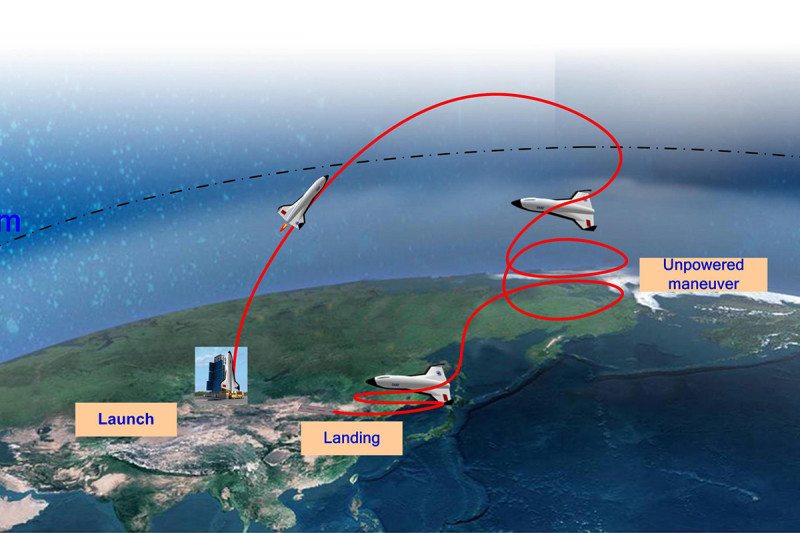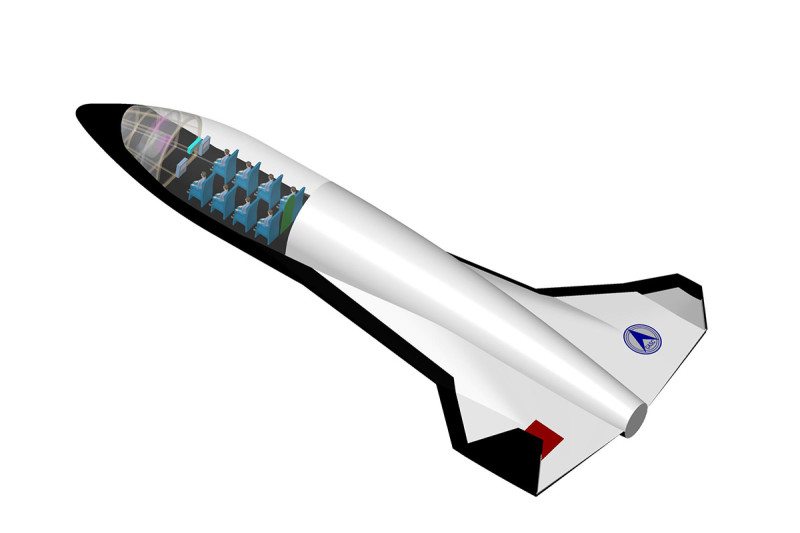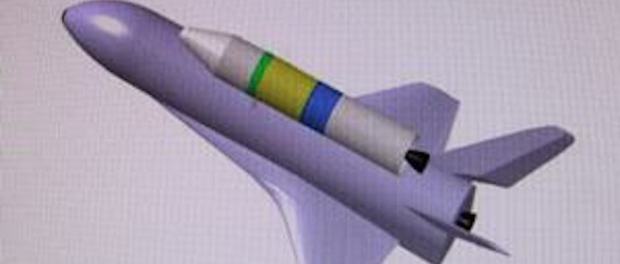4.10.2016

Mr Pengxin Han et al. from CALT
Even China can’t resist the lure of space tourism. A state-backed firm is developing a gigantic spaceplane, New Scientist can reveal. The plane may one day fly up to 20 passengers to the edge of space – significantly more people than any other commercial spaceflight firm has pledged to fly to date.
The China Academy of Launch Vehicle Technology in Beijing has designed a simple, one-piece spaceplane whose design can be scaled up to carry more people, academy rocket scientist Lui Haiquang told the International Astronautical Congress in Guadalajara, Mexico, last week.
The academy will have plenty of competition. Big names include Virgin Galactic, whose SpaceShipTwo spaceplane will offer six passengers trips to near-space, and XCOR, whose proposed Lynx vehicle will fly a single passenger seated beside a pilot. Blue Origin’s suborbital space capsule, New Shepard, aims to carry six tourists. But academy team leader Han Pengxin and his colleagues believe consumer demand will be high enough to build a much higher capacity spacecraft.
“More and more common persons are interested in the experience of space flight,” the team wrote in their IAC2016 paper, adding that the project is “very attractive” to “bosses and businessmen”.
They have designed a winged rocket that takes off under its own power. That sets it apart from SpaceShipTwo, which must be carried to high altitude by an aircraft before firing its own rocket.

Mr Pengxin Han et al. from CALT
“The vehicle will take off vertically like a rocket and land on the runway automatically without any ground or on-board intervention,” Han says. It will burn liquid methane and liquid oxygen.
Han’s team has designed two versions of their rocket plane. The first has a mass of 10 tonnes and a wingspan of 6 metres. This one, he says, should be able to fly five people to an altitude of 100 kilometres – where space officially begins – at speeds up to Mach 6, giving 2 minutes of weightlessness.
But a scaled up 100-tonne version, with a 12-metre wingspan, could fly 20 people to 130 kilometres at Mach 8, giving 4 minutes of weightlessness. That larger spacecraft is fast enough to help deliver small satellites into orbit, with the help of a small rocket stage add-on that would sit on top of the vehicle. And that payload-carrying capability will reduce tourist ticket prices, says Han. They also intend to make it reusable, so each plane should be good for up to 50 flights.
Test flights soon
Tests are advanced, Han adds. “The test flights will be finished in the next two years, because almost all of the ground tests have been finished and all the subsystems of the test vehicle worked very well.”
He imagines flights will launch from a commercial spaceport – whose location is as yet undecided – with payload launches in 2020. The plane will carry people when it is considered safe enough.
Han predicts that a ride will cost between $200,000 and $250,000.
Some are sceptical of the team’s claims. The spaceplane is an “interesting initiative”, says spaceflight expert Roger Launius at the Smithsonian Institution’s National Air and Space Museum in Washington DC, but he’s concerned about the lack of technical details in their four-page IAC paper.
“The most unusual part is the belief that they can send up to 20 people to 100 kilometres and more on a rocket without a mother ship and no staging, reusing it some 50 times,” he says. “It’s not explained how that will be accomplished. And the fact that they think they can test fly in the next 2 years is remarkable.”
So the onus is on the academy to prove this is more than a paper spaceplane, says Launius. “It is always easier to draw illustrations and talk possibilities than to build and fly spacecraft.
Others are more charitable. Outlandish as a 20-person spaceplane sounds, said a delegate at the IAC, who preferred to remain anonymous, the Beijing team’s aims are not impossible. “From an engineering standpoint, all the spaceflight operations the Chinese team suggest have been proven before. Whether they can do it safely, however, and make a viable suborbital business out if it, is another question.”
Quelle: NewScientist
-
Update: 29.10.2016
.
China plans to develop CZ-8 and re-useable launch system
In addition to conventional expandable rockets, China’s future space launcher fleet will also include re-useable launch system, low-cost rapid-response launch vehicle, and super-heavy launch vehicle, according to a recently-published industrial development plan.
The Chinese Ministry of Industry and Information Technology (MIIT) recently revealed its roadmap for advancing the country’s industrial capabilities over the next five years (2016-2020), as part of the government’s “Made in China 2025” initiative aimed to upgrade industrial infrastructure and promote intelligence manufacturing. The roadmap outlined a number of key priorities for China’s civilian space programme by 2020, ranging from space launch systems, civilian space infrastructure, deep space exploration, space applications, to space-based information systems.
Under the Space Transportation System Programme (航天运输系统专项), the MIIT plan states:
重点支持长征五号、八号,低成本快速响应运载火箭,可重复使用天地往返运输系统等新一代运载火箭系统,以及重型运载火箭工程。
Priorities will be given to new-generation launch systems including the CZ-5, CZ-8, low-cost rapid-response launch vehicle, reusable space-earth transportation system, as well as the heavy launch vehicle project.
When the Chinese space industry began to develop its new-generation launch vehicle family in the early 2000s, three models were originally planned. These eventually evolved into the heavy-load CZ-5, the medium-load CZ-7, and the small-load CZ-6. However, in 2015 a space official disclosed to the press that the concept of a fourth variant debuted CZ-8 was being evaluated. He revealed that the CZ-8 was primarily intended for Sun-Synchronous Orbit (SSO) launch missions.
The CZ-8 was mentioned once again during a press conference held by the China National Space Agency (CNSA) in May this year, when the agency revealed that breakthrough in the new-generation kerosene and liquid-hydrogen rocket engine technologies would pave the way for the development of new-generation launch vehicles including CZ-6, CZ-7 and CZ-8. It is expected that the CZ-8 will make its debut flight by 2020. Once operational, it will replace the CZ-4B/C in current service.
As to the “low-cost rapid-response launch vehicle”, the plan document did not explain which specific model this was referring to, but both of China’s two aerospace corporations are currently promoting their small-load launch vehicles with varying degrees of rapid launch capability. The China Aerospace Science and Technology Corporation (CASC) has test launched the liquid-fuelled CZ-6 and the solid-fuelled CZ-11. The China Aerospace Science and Industry Corporation (CASIC) has made two successful flights with its solid-fuel, mobile-launched Kuaizhou (KZ). The improved KZ-1A is scheduled for its maiden launch in late 2016, and the larger KZ-11 and KZ-21 are also under development.
No doubt the most exciting revelation in the plan document is the “reusable space-earth transportation system”. Previously this only existed in research papers but the MIIT plan implies that the system is now in development. No detail on this system is available, but some sketchy information circulating on Chinese social media suggests that China Academy of Launch Vehicle Technology (CALT) of the CASC is currently developing a launch vehicle system with recoverable first-stage and boosters, similar to the concept of the SpaceX Falcon 9 v1.1. However, launch vehicle with recoverable boosters won’t be the only option to achieve reusability, as CALT has also been studying various winged reusable systems (shuttle or spaceplane) since the late 1980s.

CALT mini shuttle concept
In 2006, CALT was reported to have been developing two reusable launch vehicle concepts. The first design, possibly a derivative of its Tiao Jiao 1 concept (Programme 863-204) of the 1980s, is said to be a small crewed shuttle system launched vertically atop the CZ-5 launch vehicle and landing horizontally through unpowered glide. The orbiter vehicle is about one sixth the size of the NASA Space Shuttle. The second design is a smaller unmanned, horizontal take-off and landing (HTHL) suborbital spaceplane that could launch a small second-stage rocket capable of placing 1,000 kg payload into orbit. In 2013, Chinese social media unveiled that CALT had conducted an automated high-speed approach and landing test for a “key aerospace system”.
In July this year, China’s state media reported that CALT was studying a revolutionary hybrid-power spacecraft vehicle, which will rely on turbine, ramjet and rocket engines to power the vehicle in different phases of the flight into orbit. It hopes that such technology will significantly reduce the cost for orbital travel.
Last but the not the least, the Chinese space industry is making breakthrough in high-thrust rocket engine technologies, which will eventually allow the development of a super-heavy launch vehicle designated CZ-9. Similar in size and capability to the NASA Space Launch System (SLS), the CZ-9 will be used to support China’s future deep space explorations including manned lunar landing and missions to Mars.
Quelle: CSR

